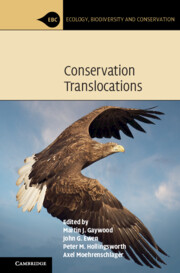Book contents
- Frontmatter
- Dedication
- Contents
- Contributors
- Foreword
- Preface
- Acknowledgements
- Part I Conservation Translocations: Getting Started
- Part II Conservation Translocations: The Key Issues
- Part III Conservation Translocations: Looking to the Future
- Part IV Case Studies
- 14 Reintroduction of the Endemic Plant Manglietiastrum sinicum (Magnoliaceae) to Yunnan Province, China
- 15 Applying Adaptive Management to Reintroductions of Pyne’s Ground-Plum Astragalus bibullatus
- 16 Five Reasons to Consider Long-Term Monitoring: Case Studies from Bird Reintroductions on Tiritiri Matangi Island
- 17 Multiple Reintroductions to Restore Ecological Interactions in a Defaunated Tropical Forest
- 18 Bringing Jaguars and Their Prey Base Back to the Iberá Wetlands, Argentina
- 19 The Return of the Eurasian Beaver to Britain: The Implications of Unplanned Releases and the Human Dimension
- 20 The Role of Community Engagement in Conservation Translocations: The South of Scotland Golden Eagle Project (SSGEP)
- 21 The European Native Oyster and the Challenges for Conservation Translocations: The Scottish Experience
- 22 Slow and Steady Wins the Race: Using Non-native Tortoises to Rewild Islands off Mauritius
- 23 Assisted Colonisation as a Conservation Tool: Tasmanian Devils and Maria Island
- Index
- Plates
19 - The Return of the Eurasian Beaver to Britain: The Implications of Unplanned Releases and the Human Dimension
from Part IV - Case Studies
Published online by Cambridge University Press: 07 December 2022
- Frontmatter
- Dedication
- Contents
- Contributors
- Foreword
- Preface
- Acknowledgements
- Part I Conservation Translocations: Getting Started
- Part II Conservation Translocations: The Key Issues
- Part III Conservation Translocations: Looking to the Future
- Part IV Case Studies
- 14 Reintroduction of the Endemic Plant Manglietiastrum sinicum (Magnoliaceae) to Yunnan Province, China
- 15 Applying Adaptive Management to Reintroductions of Pyne’s Ground-Plum Astragalus bibullatus
- 16 Five Reasons to Consider Long-Term Monitoring: Case Studies from Bird Reintroductions on Tiritiri Matangi Island
- 17 Multiple Reintroductions to Restore Ecological Interactions in a Defaunated Tropical Forest
- 18 Bringing Jaguars and Their Prey Base Back to the Iberá Wetlands, Argentina
- 19 The Return of the Eurasian Beaver to Britain: The Implications of Unplanned Releases and the Human Dimension
- 20 The Role of Community Engagement in Conservation Translocations: The South of Scotland Golden Eagle Project (SSGEP)
- 21 The European Native Oyster and the Challenges for Conservation Translocations: The Scottish Experience
- 22 Slow and Steady Wins the Race: Using Non-native Tortoises to Rewild Islands off Mauritius
- 23 Assisted Colonisation as a Conservation Tool: Tasmanian Devils and Maria Island
- Index
- Plates
Summary
The Eurasian beaver has returned to Britain, presenting fundamental challenges and opportunities for all involved. Beavers will inevitably expand throughout British freshwater systems and provide significant benefits. Unofficial releases have presented challenges in terms of sourcing and genetics, health status and disease risks, the risk of introducing the non-native North American beaver species, and the lack of engagement with communities and resulting conflict. Agreed approaches require development using multi-stakeholder approaches to recognise and promote benefits whilst sensitively managing beavers’ impacts on people’s livelihoods.
Keywords
- Type
- Chapter
- Information
- Conservation Translocations , pp. 449 - 455Publisher: Cambridge University PressPrint publication year: 2022

